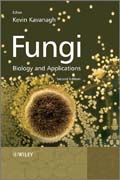
Fungi: Biology and Applications , Second Edition provides a comprehensive treatment of fungi, covering biochemistry, genetics and the medical and economic significance of these organisms at introductory level. With no prior knowledge of the subject assumed, the opening chapters offer a broad overview ofthe basics of fungal biology, in particular the physiology and genetics of fungi and also a new chapter on the application of genomics to fungi. Laterchapters move on to include more detailed coverage of topics such as antibiotic and chemical commodities from fungi, new chapters on biotechnological use of fungal enzymes and fungal proteomics, and fungal diseases of humans , antifungal agents for use in human therapy and fungal pathogens of plants. INDICE: List of Contributors. Preface. 1. Introduction to Fungal Physiology (Graeme M. Walker and Nia A. White). 1.1 Introduction 1.2 Morphology of Yeasts and Fungi 1.3 Ultrastructure and Function of Fungal Cells 1.4 Fungal Nutrition and Cellular Biosyntheses 1.5 Fungal Metabolism 1.6 Fungal Growth and Reproduction 1.7 Conclusions Revision Questions References Further Reading 2. Fungal Genetics (Malcolm Whiteway and Catherine Bachewich) 2.1 Introduction 2.2 Fungal Life Cycles 2.3 Sexual Analysis: Regulation of Mating 2.4 Unique Characteristics of Filamentous Fungi that are Advantageous for Genetic Analysis 2.5 Genetics as a Tool 2.6 Conclusion Acknowledgement Revision Questions References Further Reading 3. Fungal Genomics (David Fitzpatrick and Edgar Mauricio Medina Tovar) 3.1 Introduction 3.2 Genome Sequencing 3.3 Bioinformatics Tools 3.4 Comparative Genomics 3.5 Genomics and the Fungal Tree of Life 3.6 Online FungalGenomic Resources 3.7 Conclusion Revision Questions Further Reading 4. FungalGenetics: A Post-Genomic Perspective (Brendan Curran and Virginia Bugeja) 4.1Introduction 4.2 Genomics 4.3 Transcriptomics and Proteomics 4.4 Proteomics 4.5 Systems Biology 4.6 Conclusion 4.7 Revision Questions References Further Reading 5. Fungal Fermentation Systems and Products (Kevin Kavanagh) 5.1 Introduction 5.2 Fungal Fermentation Systems 5.3 Commercial Fungal Products 5.4 Conclusion Revision Questions References Further Reading 6. Pharmaceutical and Chemical Commodities from Fungi (Karina A. Horgan and Richard A. Murphy) 6.1 Introduction to Pharmaceutical and Chemical Commodities 6.2 Fungal Metabolism 6.3 Antibiotic Production 6.4 Pharmacologically Active Products 6.5 Chemical Commodities 6.6 Yeast Extracts 6.7 Enriched Yeast 6.8 Conclusions Revision QuestionsReferences Further Reading 7. Biotechnological Use of Fungal Enzymes (Shauna M. McKelvey and Richard A. Murphy) 7.1 Introduction to Enzymes 7.2 Enzymes in Industry 7.3 Current Enzyme Applications 7.4 Future Direction of Industrial Enzymes 7.5 Specific Enzymes 7.6 Enzyme Production Strategies 7.7 Conclusions Revision Questions References Further Reading 8. The Biotechnological Exploitation of Heterologous Protein Production in Fungi (Brendan Curran and Virginia Bugeja) 8.1 Introduction 8.2 Heterologous Protein Expression in Fungi 8.3 Case Study: Hepatitis B Vaccine: A Billion Dollar Heterologous Protein from Yeast 8.4 Further Biotechnological Applications of Expression Technology 8.5 Conclusions Revision Questions Further Reading 9. Fungal Proteomics (Sean Doyle) 9.1 Introduction 9.2 Protein Isolation and Purification 9.3 Electrophoretic Techniques 9.4 Protein Mass Spectrometry 9.5 Fungal Proteomics 9.6 Specialized Proteomics Applications in Fungal Research 9.7 Conclusion Revision Questions Further Reading 10. Fungal Infections of Humans (Derek J. Sullivan, Gary P. Moran and David C. Coleman) 10.1 Introduction 10.2 Superficial Mycoses 10.3 Opportunistic Mycoses 10.4 Endemic Systemic Mycoses 10.5
- ISBN: 978-0-470-97710-1
- Editorial: John Wiley & Sons
- Encuadernacion: Cartoné
- Páginas: 384
- Fecha Publicación: 30/09/2011
- Nº Volúmenes: 1
- Idioma: Inglés
